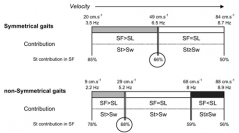

 Comptes Rendus Palevol
5 (3-4) - Pages 531-540
Comptes Rendus Palevol
5 (3-4) - Pages 531-540We analysed treadmill locomotion of the adult SWISS-OF1 mice over a large range of velocities. The use of a high-speed video camera combined with cinefluoroscopic equipment allowed us to quantify in detail the various space and time parameters of limb kinematics. We find that velocity adjustments depend upon whether animal used a symmetrical or non-symmetrical gait. In symmetrical gaits, the increase of velocity generally results equally from an increase in the stride frequency and the stride length. On the other hand, in non-symmetrical gaits, the increase in velocity is achieved differently according to the level of velocity used. As speed increases, velocity increases first as a consequence of increased stride frequency, then as in symmetrical gaits, by an equal increase in both variables, and finally at high speed, velocity increases through increased stride length. In both symmetrical and non-symmetrical gaits, stance and swing-time shortening contributed to the increase of the stride frequency, with stance time decrease being the major contributor. The pattern of locomotion obtained in the present study may be used as a model mouse system for studying locomotor deficits resulting from specific mutations in the nervous system.
Stride frequency, Stride length, Treadmill, Locomotion, SWISS-OF1